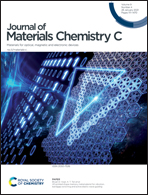Long-range exciton diffusion in a non-fullerene acceptor: approaching the incoherent limit†
Abstract
In organic photovoltaic cells, absorption of light leads to the formation of excitons, which then diffuse to the donor/acceptor interface to generate photocurrent. The distance from which excitons can reach the interface is constrained by the exciton diffusion length, which has been difficult to quantitatively model or predict due to structural and energetic disorder. Modern non-fullerene acceptors have been shown to possess exceptionally large diffusion lengths, along with well-defined molecular and packing structures, suggesting that a predictive framework for materials design and computational screening may be possible. In this work, we demonstrate that the large diffusion coefficient recently observed in an archetypical non-fullerene acceptor, IDIC, can be accurately quantified using density functional theory, and that the low energetic disorder means that the crystal structure provides a meaningful starting point to understand exciton motion in thin films. Accounting for the short- and long-range excitonic interactions, as well as spatiotemporal disorder, we demonstrate that both Monte-Carlo techniques and a simple sum-over-rates method can accurately predict experimental values for exciton diffusivity and diffusion length. The simplicity and accuracy of this approach are directly linked to the structural order of these materials, and an electronic coupling profile that is unusually resilient to thermal distortions – highlighting the potential of the sum-over-rates method for computational materials screening. Moreover, we show that these factors, combined with the low reorganisation energy and significant long-range electronic coupling, lead to diffusion rates that approach the upper limit of incoherent energy transfer and long diffusion lengths that relieve constraints on organic solar cell device architectures.



 Please wait while we load your content...
Please wait while we load your content...